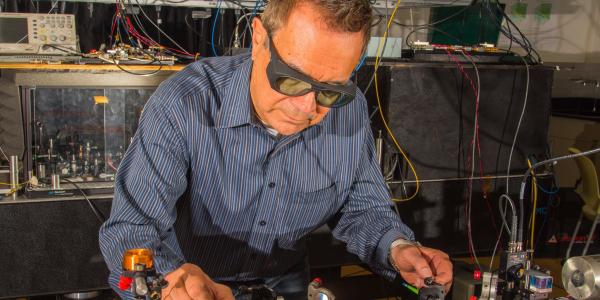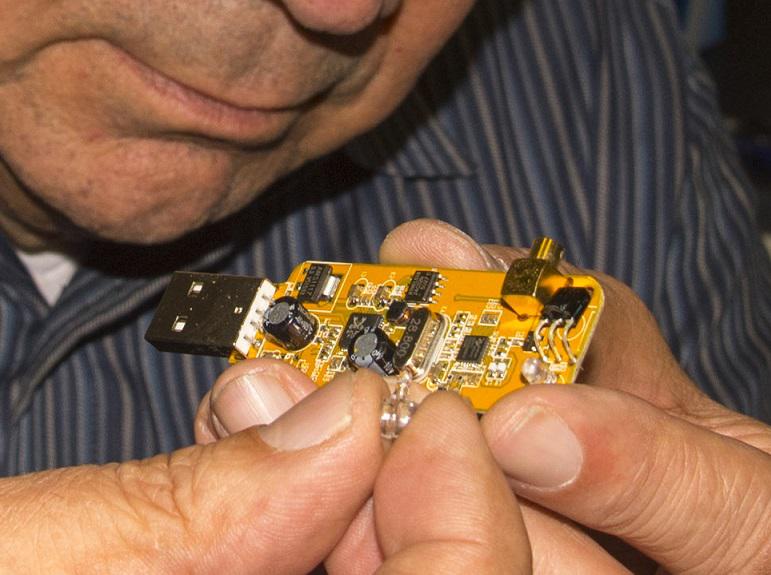Quantum Radio Takes a Giant Leap
A quantum physics-based technology developed by National Institute of Standards and Technology researchers may enable first responders, warfighters and mariners to communicate and navigate in areas where radio and satellite-based communications are limited or nonexistent. The capability would allow military and emergency personnel to stay connected in urban canyons, under rubble, inside buildings, underground or even underwater.
The system uses an atomic magnetometer as a radio receiver to detect very low frequency (VLF) digitally modulated magnetic signals. At its heart is a miniscule glass vial containing rubidium atoms illuminated by a laser that perceives changes in the atoms’ spin as they’re affected by a signal. This quantum property allows the device to detect VLF magnetic signals, which can travel farther through rock, dirt, concrete and water than conventional communications signals at higher frequencies.
For the project, National Institute of Standards and Technology (NIST) researchers developed a direct-current (DC) magnetometer using polarized laser light as a detector to measure the spin of the rubidium atoms induced by magnetic fields. Changes in the atom’s spin rate correspond to an oscillation in the DC magnetic fields. This oscillation creates an alternating current electronic signal, or voltage at the laser light detector, which is more useful for communications.
Acting as a receiver, the magnetometer and its rubidium atoms allow researchers to detect digitally modulated magnetic signals sending digital bits of information in 1s and 0s. Researchers varied the magnetic fields to control the frequency—the horizontal and vertical positions of the signal’s waveform—created by the atoms.
“Atoms offer very fast response plus very high sensitivity,” explains David Howe, a senior professional research adviser at NIST and project manager for the institute’s quantum radio effort in Boulder, Colorado. “Classical communications involves a trade-off between bandwidth and sensitivity. We can now get both with quantum sensors.”
To develop the quantum radio, NIST scientists invented a new field, combining quantum physics with low frequency magnetic radio research. Howe explains that the new field’s methodology involves innovative ways of thinking about how to measure electromagnetic signals in greater detail and ways of adapting existing technologies to those tasks.
The U.S. Defense Department has shown interest in the technology, and NIST has received additional funding from the Office of Naval Research and the Army Research Laboratory to help develop quantum radio technology. With the prototype quantum radio complete, the organization is reaching out to the private sector and government agencies like the Defense Department to develop a production model.
One of the problems with traditional VLF radio communications is that they require very large antennas. In the case of a first responder-usable device, this might require a hypothetical loop antenna as large as a person. One advantage of atomic magnetometers is their very small size, making them ideal for handheld devices. In addition, unlike cumbersome antennas, quantum magnetometers provide superior magnetic field sensitivity, Howe explains.
Another issue with VLF communications, including magnetic radios, is poor receiver sensitivity and extremely limited bandwidth of existing transmitters and receivers. “This means the data rate is zilch,” he relates.
Researchers have been considering the communications potential of quantum sensors for some time, Howe says. The initial goal was helping first responders communicate with each other and surface teams in underground or indoor environments. Commercially available underground communications systems provide miners with a means of communications during a cave-in, but Howe notes that these systems are large and most are stationary, which makes them unsuitable for search and rescue teams.
Another domain where a quantum radio offers many advantages is underwater. Submarines currently use VLF radio to communicate, but this involves deploying long cables and rising to periscope depth, about 60 feet below the surface. Bandwidth also is extremely limited, making most communications a series of one-way text messages.
NIST’s quantum radio method is more sensitive than current magnetic sensor technology methods, Howe explains. A key step was developing a signal processing technique to reduce naturally occurring and man-made environmental noise that can otherwise limit communications range.
For example, electromagnetic signal noise from power lines is a major hurdle for VLF communications. However, VLF radios can operate in the low spots on the power line noise spectrum as can the magnetometers used in NIST’s radios. Howe notes that this signal processing technique allows fainter signals to be detected, which increases the signal’s range.
“The best magnetic field sensitivity is obtained using quantum sensors. The increased sensitivity leads in principle to longer communications range,” Howe says. “The quantum approach also offers the possibility to get high bandwidth communications like a cellphone. We need bandwidth to communicate with audio underwater and in other forbidding environments.”
Besides high sensitivity, the “optically pumped” magnetometers have several key advantages, such as room-temperature operation, small size, low power requirements, reduced cost and improved signal reception. Howe adds that this kind of sensor does not drift or require calibration.
During testing, the quantum sensor detected signals significantly weaker than the average background magnetic field noise. It could sense digitally modulated magnetic field signals as weak as 1 picotesla, or one millionth of the Earth’s magnetic field strength, and at very low frequencies, below 1 kilohertz (kHz).
Howe notes that this is below VLF radio frequencies, which span from 3 kHz to 30 kHz and are used for some government and military applications. The NIST-developed modulation technique suppressed the ambient noise and its harmonics, which increased the quantum radio’s channel capacity.
NIST researchers also conducted tests to estimate the limits of effective communications and location-ranging capabilities. The indoor quantum radio range with a good signal-to-noise ratio was tens of meters. However, this could be extended by hundreds of meters if the noise was reduced to the sensor’s sensitivity levels, which is better than what is currently possible indoors with available technologies, Howe says.
But some aspects of the radio system need refining. One remaining challenge pertains to accurate location fixes. NIST’s prototype device has an uncertainty of up to 52 feet in its location reporting, which is much more than the goal of 10 feet. Howe explains that this capability could be improved with future noise suppression techniques, increased sensor bandwidth and improved algorithms to produce exact distance measurements accurately.
NIST researchers now are building and testing an improved quantum magnetometer. This device derives much of its inner workings from the institute’s research into small atomic clocks, Howe shares. Like an atomic clock, the device detects signals by their effect on the atoms’ internal energy levels. Researchers hope the new magnetometer and its boosted sensitivity will increase the ranges at which the quantum radio can detect VLF magnetic field signals and, by more effectively suppressing noise, expand the breadth and efficiency of the sensor’s bandwidth.
One challenge facing VLF technology is noise reduction. Because of man-made and naturally occurring noise at very low frequencies, a variety of noise filtering methods are being considered. One drawback to added sensor sensitivity is that it enhances background noise. “But the idea of having more bandwidth means you’re having more ability to use a whole toolkit of noise reduction techniques that are very, very good at this point,” Howe says.
As an example, researchers can run incoming signals through a digital filter. The advantage of the digital method is that it allows the signal to be briefly saved and recirculated through the filter’s noise-filtering algorithms, further enhancing the signal. The trade-off is a brief delay as the incoming signal is stored and run multiple times through the filter; however, the advantage for VLF radios is enormous because it enables highly sensitive filters to produce audio from the faintest signals picked up by the quantum receiver, Howe says.






Comment
My company, KenCast, Inc.,
My company, KenCast, Inc., provide the Content Delivery Network for the U.S. Military (the DISA GBS). This new Quantum Radio technology will be very helpful for the work we do for DISA GBS.
Interesting technology,
Interesting technology, someday when we understand subspace dimensions, we will have sub-space communications that will instantly travel millions of miles in seconds. Quantum communications will be the start.
Comments